Financial Budget and Cost Analysis Report - Semester 1
VerifiedAdded on 2019/12/18
|10
|3399
|164
Report
AI Summary
This report provides a detailed analysis of budget and cost management, focusing on the selection and implementation of a flexible budget. It explores the alignment of budgets with organizational goals and strategies, emphasizing the importance of timing and timeframes in budget preparation. The report identifies key costs, revenues, and cost drivers, distinguishing between fixed and variable costs. It also discusses information gathering methods, including the use of financial statements and costing sheets, and the application of activity-based costing (ABC). Furthermore, the report highlights the significance of budget sign-off procedures and the measurement and monitoring of performance against the budget. Finally, it addresses the communication of the budget and strategies for encouraging staff to meet budget targets, culminating in a concise conclusion.
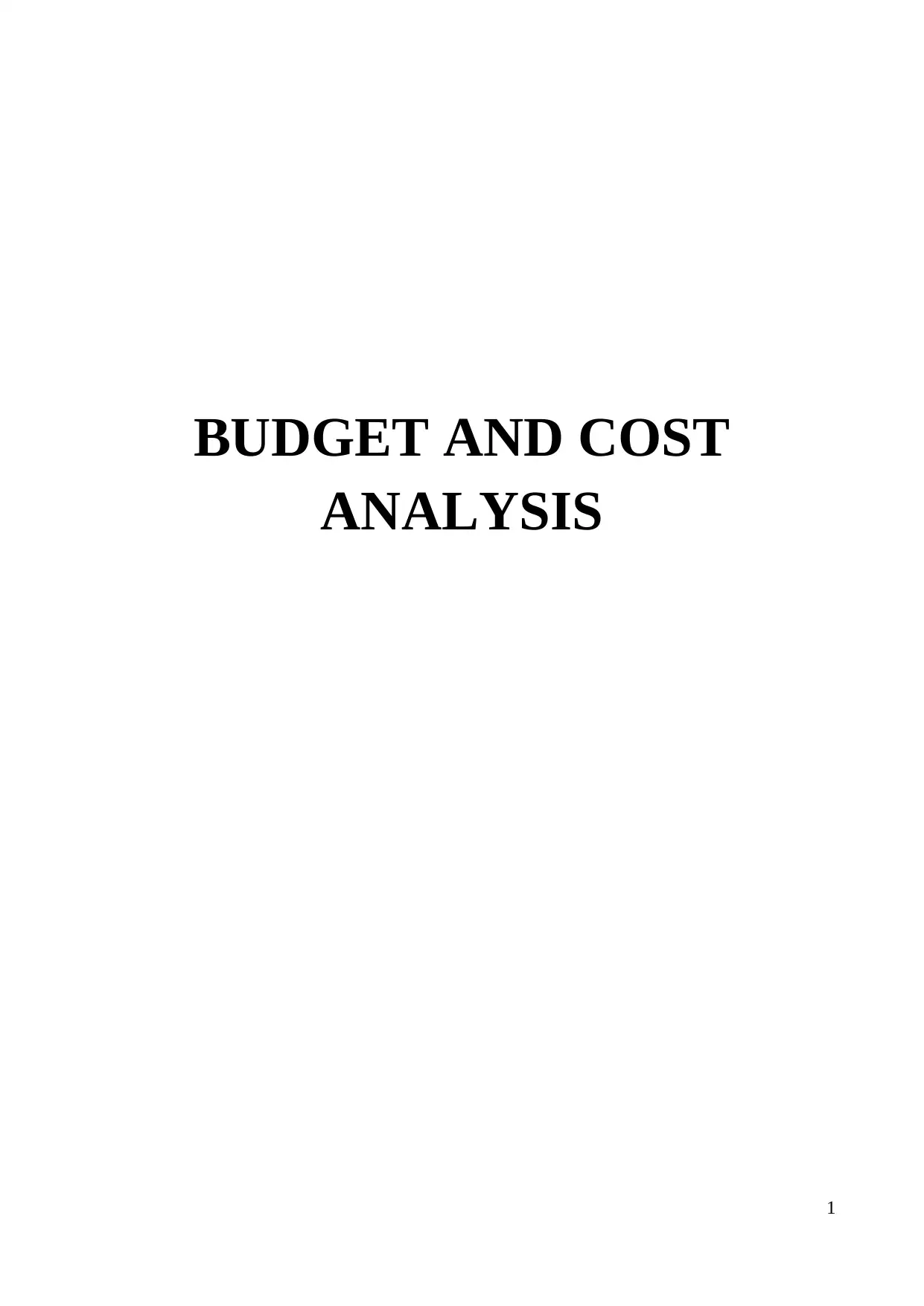
BUDGET AND COST
ANALYSIS
1
ANALYSIS
1
Paraphrase This Document
Need a fresh take? Get an instant paraphrase of this document with our AI Paraphraser
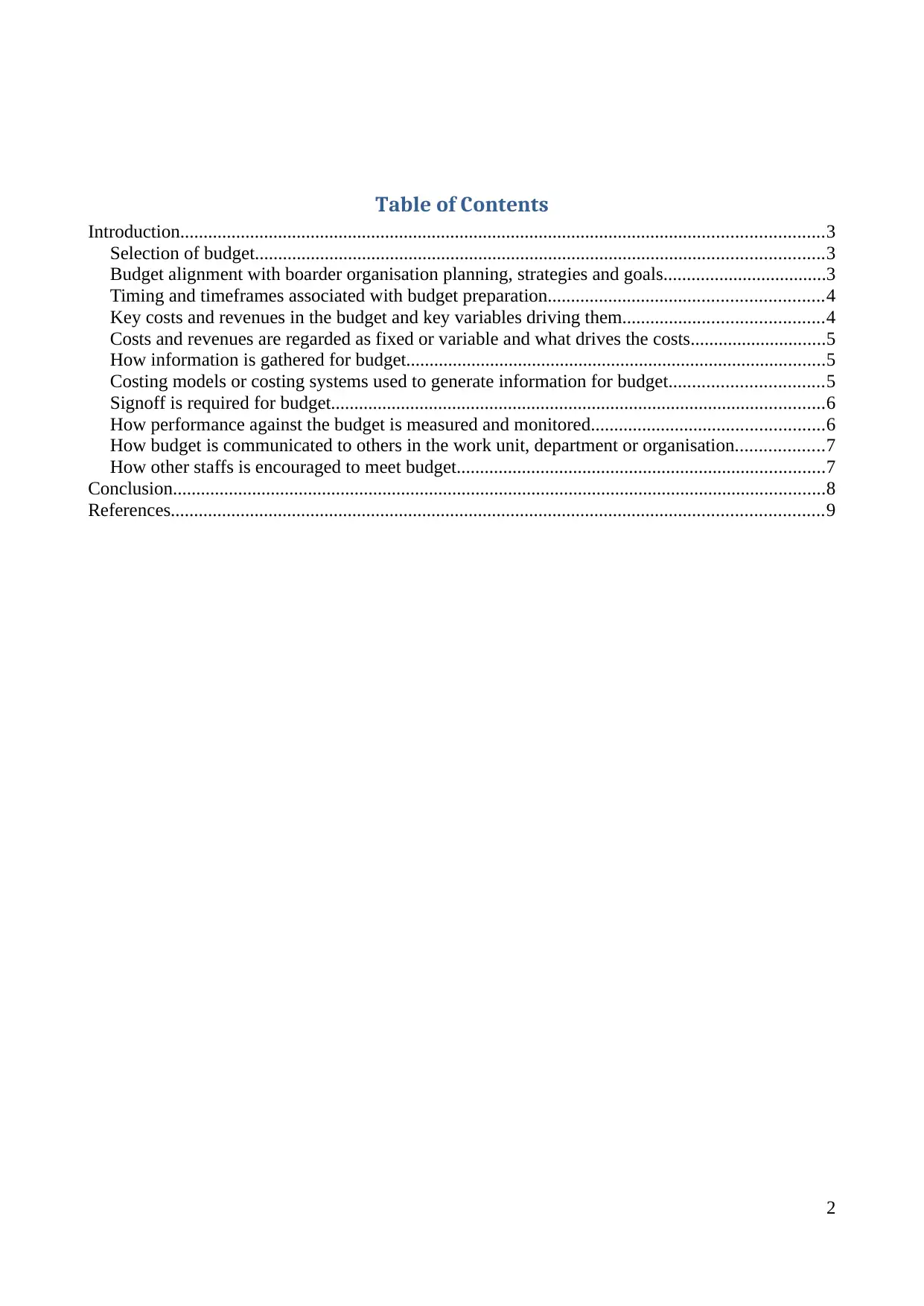
Table of Contents
Introduction..........................................................................................................................................3
Selection of budget..........................................................................................................................3
Budget alignment with boarder organisation planning, strategies and goals...................................3
Timing and timeframes associated with budget preparation...........................................................4
Key costs and revenues in the budget and key variables driving them...........................................4
Costs and revenues are regarded as fixed or variable and what drives the costs.............................5
How information is gathered for budget..........................................................................................5
Costing models or costing systems used to generate information for budget.................................5
Signoff is required for budget..........................................................................................................6
How performance against the budget is measured and monitored..................................................6
How budget is communicated to others in the work unit, department or organisation...................7
How other staffs is encouraged to meet budget...............................................................................7
Conclusion............................................................................................................................................8
References............................................................................................................................................9
2
Introduction..........................................................................................................................................3
Selection of budget..........................................................................................................................3
Budget alignment with boarder organisation planning, strategies and goals...................................3
Timing and timeframes associated with budget preparation...........................................................4
Key costs and revenues in the budget and key variables driving them...........................................4
Costs and revenues are regarded as fixed or variable and what drives the costs.............................5
How information is gathered for budget..........................................................................................5
Costing models or costing systems used to generate information for budget.................................5
Signoff is required for budget..........................................................................................................6
How performance against the budget is measured and monitored..................................................6
How budget is communicated to others in the work unit, department or organisation...................7
How other staffs is encouraged to meet budget...............................................................................7
Conclusion............................................................................................................................................8
References............................................................................................................................................9
2
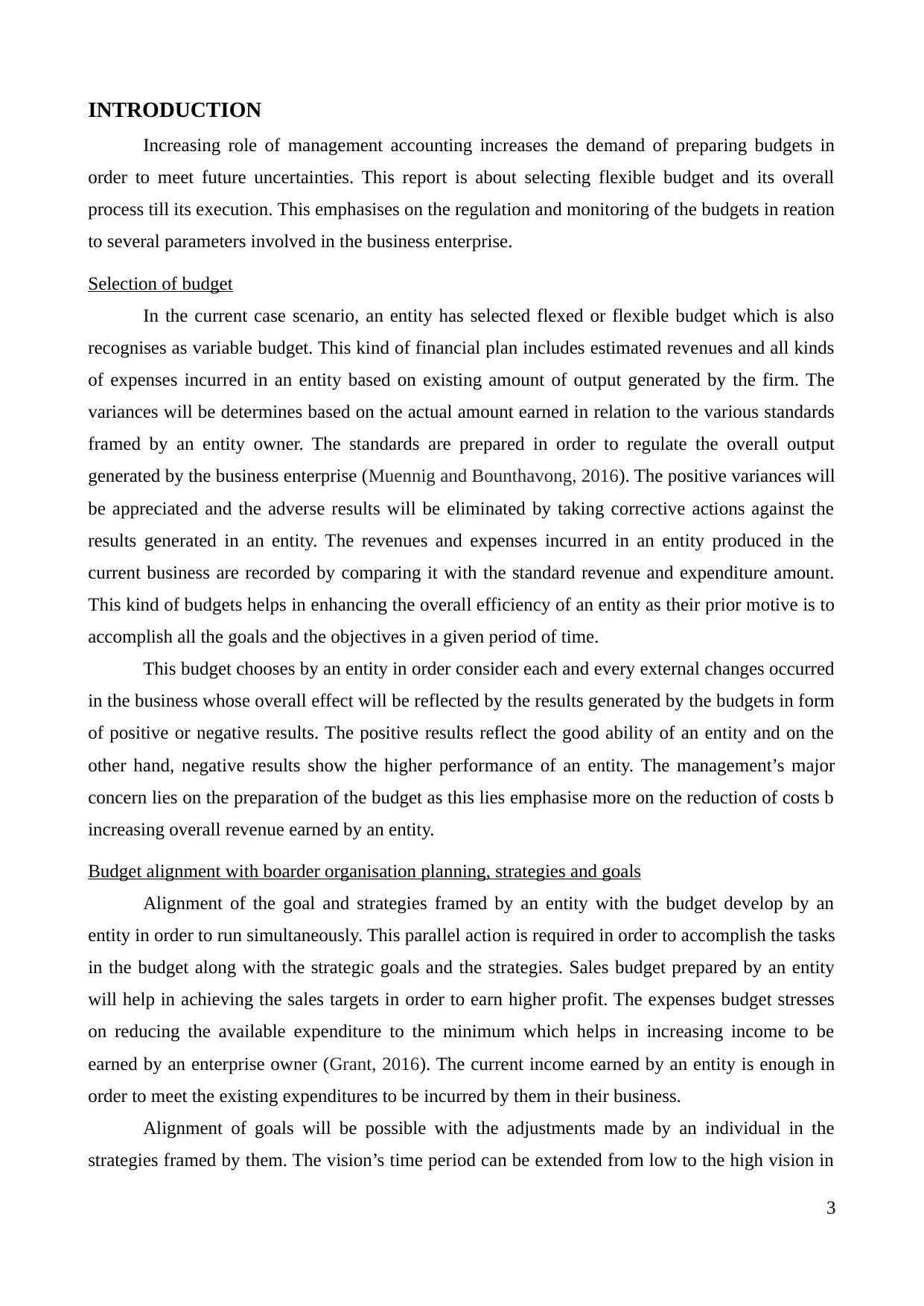
INTRODUCTION
Increasing role of management accounting increases the demand of preparing budgets in
order to meet future uncertainties. This report is about selecting flexible budget and its overall
process till its execution. This emphasises on the regulation and monitoring of the budgets in reation
to several parameters involved in the business enterprise.
Selection of budget
In the current case scenario, an entity has selected flexed or flexible budget which is also
recognises as variable budget. This kind of financial plan includes estimated revenues and all kinds
of expenses incurred in an entity based on existing amount of output generated by the firm. The
variances will be determines based on the actual amount earned in relation to the various standards
framed by an entity owner. The standards are prepared in order to regulate the overall output
generated by the business enterprise (Muennig and Bounthavong, 2016). The positive variances will
be appreciated and the adverse results will be eliminated by taking corrective actions against the
results generated in an entity. The revenues and expenses incurred in an entity produced in the
current business are recorded by comparing it with the standard revenue and expenditure amount.
This kind of budgets helps in enhancing the overall efficiency of an entity as their prior motive is to
accomplish all the goals and the objectives in a given period of time.
This budget chooses by an entity in order consider each and every external changes occurred
in the business whose overall effect will be reflected by the results generated by the budgets in form
of positive or negative results. The positive results reflect the good ability of an entity and on the
other hand, negative results show the higher performance of an entity. The management’s major
concern lies on the preparation of the budget as this lies emphasise more on the reduction of costs b
increasing overall revenue earned by an entity.
Budget alignment with boarder organisation planning, strategies and goals
Alignment of the goal and strategies framed by an entity with the budget develop by an
entity in order to run simultaneously. This parallel action is required in order to accomplish the tasks
in the budget along with the strategic goals and the strategies. Sales budget prepared by an entity
will help in achieving the sales targets in order to earn higher profit. The expenses budget stresses
on reducing the available expenditure to the minimum which helps in increasing income to be
earned by an enterprise owner (Grant, 2016). The current income earned by an entity is enough in
order to meet the existing expenditures to be incurred by them in their business.
Alignment of goals will be possible with the adjustments made by an individual in the
strategies framed by them. The vision’s time period can be extended from low to the high vision in
3
Increasing role of management accounting increases the demand of preparing budgets in
order to meet future uncertainties. This report is about selecting flexible budget and its overall
process till its execution. This emphasises on the regulation and monitoring of the budgets in reation
to several parameters involved in the business enterprise.
Selection of budget
In the current case scenario, an entity has selected flexed or flexible budget which is also
recognises as variable budget. This kind of financial plan includes estimated revenues and all kinds
of expenses incurred in an entity based on existing amount of output generated by the firm. The
variances will be determines based on the actual amount earned in relation to the various standards
framed by an entity owner. The standards are prepared in order to regulate the overall output
generated by the business enterprise (Muennig and Bounthavong, 2016). The positive variances will
be appreciated and the adverse results will be eliminated by taking corrective actions against the
results generated in an entity. The revenues and expenses incurred in an entity produced in the
current business are recorded by comparing it with the standard revenue and expenditure amount.
This kind of budgets helps in enhancing the overall efficiency of an entity as their prior motive is to
accomplish all the goals and the objectives in a given period of time.
This budget chooses by an entity in order consider each and every external changes occurred
in the business whose overall effect will be reflected by the results generated by the budgets in form
of positive or negative results. The positive results reflect the good ability of an entity and on the
other hand, negative results show the higher performance of an entity. The management’s major
concern lies on the preparation of the budget as this lies emphasise more on the reduction of costs b
increasing overall revenue earned by an entity.
Budget alignment with boarder organisation planning, strategies and goals
Alignment of the goal and strategies framed by an entity with the budget develop by an
entity in order to run simultaneously. This parallel action is required in order to accomplish the tasks
in the budget along with the strategic goals and the strategies. Sales budget prepared by an entity
will help in achieving the sales targets in order to earn higher profit. The expenses budget stresses
on reducing the available expenditure to the minimum which helps in increasing income to be
earned by an enterprise owner (Grant, 2016). The current income earned by an entity is enough in
order to meet the existing expenditures to be incurred by them in their business.
Alignment of goals will be possible with the adjustments made by an individual in the
strategies framed by them. The vision’s time period can be extended from low to the high vision in
3
⊘ This is a preview!⊘
Do you want full access?
Subscribe today to unlock all pages.

Trusted by 1+ million students worldwide
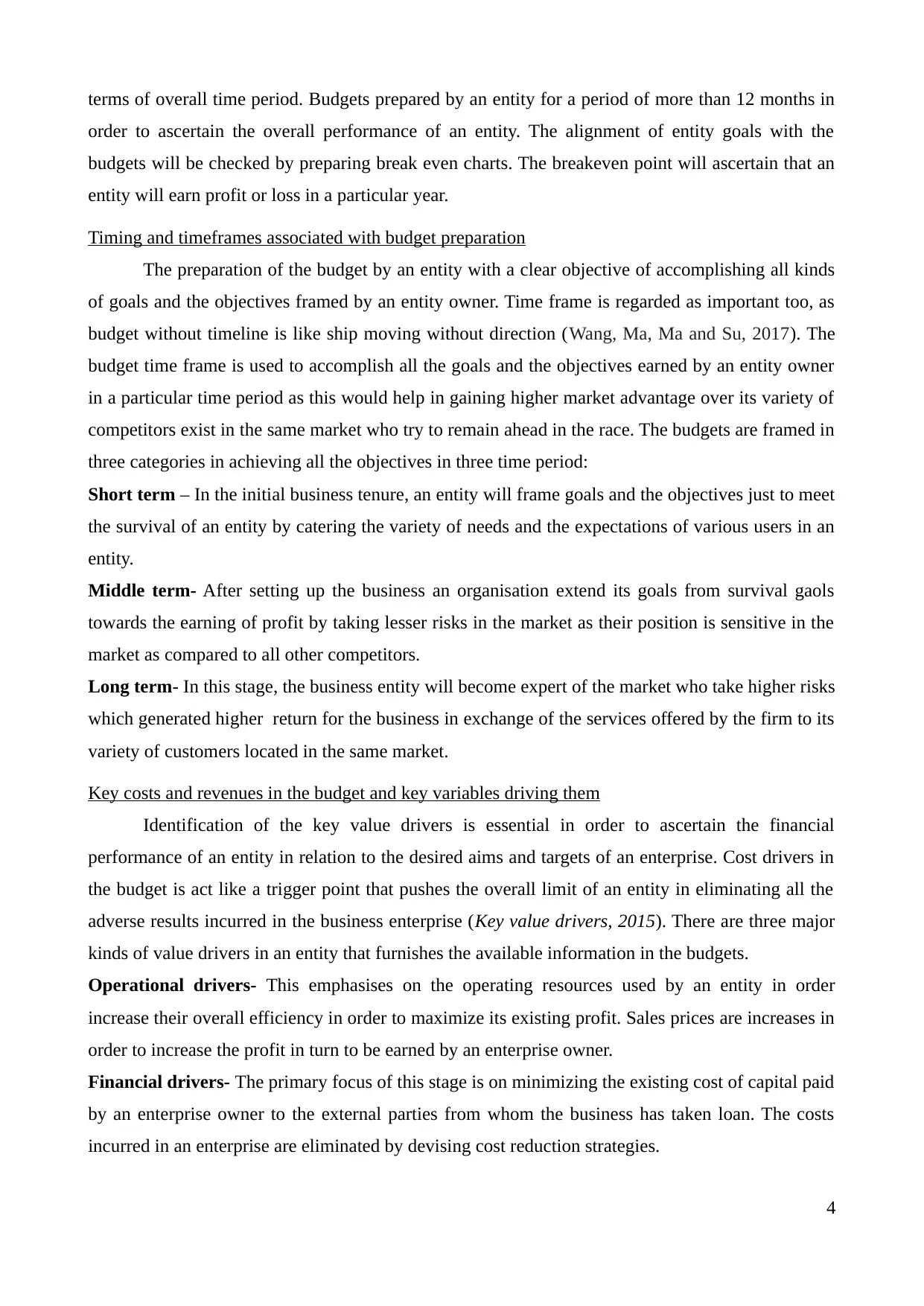
terms of overall time period. Budgets prepared by an entity for a period of more than 12 months in
order to ascertain the overall performance of an entity. The alignment of entity goals with the
budgets will be checked by preparing break even charts. The breakeven point will ascertain that an
entity will earn profit or loss in a particular year.
Timing and timeframes associated with budget preparation
The preparation of the budget by an entity with a clear objective of accomplishing all kinds
of goals and the objectives framed by an entity owner. Time frame is regarded as important too, as
budget without timeline is like ship moving without direction (Wang, Ma, Ma and Su, 2017). The
budget time frame is used to accomplish all the goals and the objectives earned by an entity owner
in a particular time period as this would help in gaining higher market advantage over its variety of
competitors exist in the same market who try to remain ahead in the race. The budgets are framed in
three categories in achieving all the objectives in three time period:
Short term – In the initial business tenure, an entity will frame goals and the objectives just to meet
the survival of an entity by catering the variety of needs and the expectations of various users in an
entity.
Middle term- After setting up the business an organisation extend its goals from survival gaols
towards the earning of profit by taking lesser risks in the market as their position is sensitive in the
market as compared to all other competitors.
Long term- In this stage, the business entity will become expert of the market who take higher risks
which generated higher return for the business in exchange of the services offered by the firm to its
variety of customers located in the same market.
Key costs and revenues in the budget and key variables driving them
Identification of the key value drivers is essential in order to ascertain the financial
performance of an entity in relation to the desired aims and targets of an enterprise. Cost drivers in
the budget is act like a trigger point that pushes the overall limit of an entity in eliminating all the
adverse results incurred in the business enterprise (Key value drivers, 2015). There are three major
kinds of value drivers in an entity that furnishes the available information in the budgets.
Operational drivers- This emphasises on the operating resources used by an entity in order
increase their overall efficiency in order to maximize its existing profit. Sales prices are increases in
order to increase the profit in turn to be earned by an enterprise owner.
Financial drivers- The primary focus of this stage is on minimizing the existing cost of capital paid
by an enterprise owner to the external parties from whom the business has taken loan. The costs
incurred in an enterprise are eliminated by devising cost reduction strategies.
4
order to ascertain the overall performance of an entity. The alignment of entity goals with the
budgets will be checked by preparing break even charts. The breakeven point will ascertain that an
entity will earn profit or loss in a particular year.
Timing and timeframes associated with budget preparation
The preparation of the budget by an entity with a clear objective of accomplishing all kinds
of goals and the objectives framed by an entity owner. Time frame is regarded as important too, as
budget without timeline is like ship moving without direction (Wang, Ma, Ma and Su, 2017). The
budget time frame is used to accomplish all the goals and the objectives earned by an entity owner
in a particular time period as this would help in gaining higher market advantage over its variety of
competitors exist in the same market who try to remain ahead in the race. The budgets are framed in
three categories in achieving all the objectives in three time period:
Short term – In the initial business tenure, an entity will frame goals and the objectives just to meet
the survival of an entity by catering the variety of needs and the expectations of various users in an
entity.
Middle term- After setting up the business an organisation extend its goals from survival gaols
towards the earning of profit by taking lesser risks in the market as their position is sensitive in the
market as compared to all other competitors.
Long term- In this stage, the business entity will become expert of the market who take higher risks
which generated higher return for the business in exchange of the services offered by the firm to its
variety of customers located in the same market.
Key costs and revenues in the budget and key variables driving them
Identification of the key value drivers is essential in order to ascertain the financial
performance of an entity in relation to the desired aims and targets of an enterprise. Cost drivers in
the budget is act like a trigger point that pushes the overall limit of an entity in eliminating all the
adverse results incurred in the business enterprise (Key value drivers, 2015). There are three major
kinds of value drivers in an entity that furnishes the available information in the budgets.
Operational drivers- This emphasises on the operating resources used by an entity in order
increase their overall efficiency in order to maximize its existing profit. Sales prices are increases in
order to increase the profit in turn to be earned by an enterprise owner.
Financial drivers- The primary focus of this stage is on minimizing the existing cost of capital paid
by an enterprise owner to the external parties from whom the business has taken loan. The costs
incurred in an enterprise are eliminated by devising cost reduction strategies.
4
Paraphrase This Document
Need a fresh take? Get an instant paraphrase of this document with our AI Paraphraser
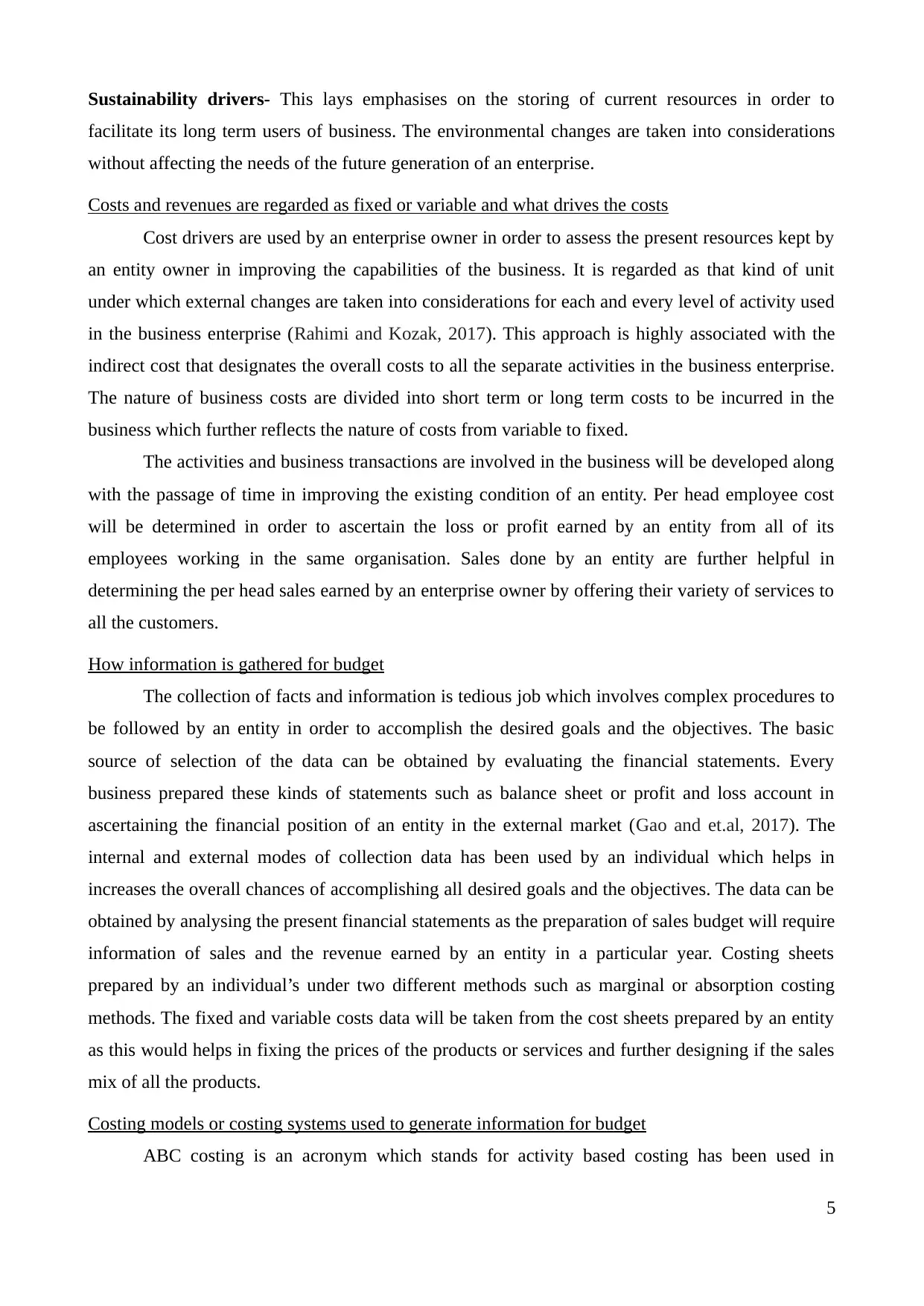
Sustainability drivers- This lays emphasises on the storing of current resources in order to
facilitate its long term users of business. The environmental changes are taken into considerations
without affecting the needs of the future generation of an enterprise.
Costs and revenues are regarded as fixed or variable and what drives the costs
Cost drivers are used by an enterprise owner in order to assess the present resources kept by
an entity owner in improving the capabilities of the business. It is regarded as that kind of unit
under which external changes are taken into considerations for each and every level of activity used
in the business enterprise (Rahimi and Kozak, 2017). This approach is highly associated with the
indirect cost that designates the overall costs to all the separate activities in the business enterprise.
The nature of business costs are divided into short term or long term costs to be incurred in the
business which further reflects the nature of costs from variable to fixed.
The activities and business transactions are involved in the business will be developed along
with the passage of time in improving the existing condition of an entity. Per head employee cost
will be determined in order to ascertain the loss or profit earned by an entity from all of its
employees working in the same organisation. Sales done by an entity are further helpful in
determining the per head sales earned by an enterprise owner by offering their variety of services to
all the customers.
How information is gathered for budget
The collection of facts and information is tedious job which involves complex procedures to
be followed by an entity in order to accomplish the desired goals and the objectives. The basic
source of selection of the data can be obtained by evaluating the financial statements. Every
business prepared these kinds of statements such as balance sheet or profit and loss account in
ascertaining the financial position of an entity in the external market (Gao and et.al, 2017). The
internal and external modes of collection data has been used by an individual which helps in
increases the overall chances of accomplishing all desired goals and the objectives. The data can be
obtained by analysing the present financial statements as the preparation of sales budget will require
information of sales and the revenue earned by an entity in a particular year. Costing sheets
prepared by an individual’s under two different methods such as marginal or absorption costing
methods. The fixed and variable costs data will be taken from the cost sheets prepared by an entity
as this would helps in fixing the prices of the products or services and further designing if the sales
mix of all the products.
Costing models or costing systems used to generate information for budget
ABC costing is an acronym which stands for activity based costing has been used in
5
facilitate its long term users of business. The environmental changes are taken into considerations
without affecting the needs of the future generation of an enterprise.
Costs and revenues are regarded as fixed or variable and what drives the costs
Cost drivers are used by an enterprise owner in order to assess the present resources kept by
an entity owner in improving the capabilities of the business. It is regarded as that kind of unit
under which external changes are taken into considerations for each and every level of activity used
in the business enterprise (Rahimi and Kozak, 2017). This approach is highly associated with the
indirect cost that designates the overall costs to all the separate activities in the business enterprise.
The nature of business costs are divided into short term or long term costs to be incurred in the
business which further reflects the nature of costs from variable to fixed.
The activities and business transactions are involved in the business will be developed along
with the passage of time in improving the existing condition of an entity. Per head employee cost
will be determined in order to ascertain the loss or profit earned by an entity from all of its
employees working in the same organisation. Sales done by an entity are further helpful in
determining the per head sales earned by an enterprise owner by offering their variety of services to
all the customers.
How information is gathered for budget
The collection of facts and information is tedious job which involves complex procedures to
be followed by an entity in order to accomplish the desired goals and the objectives. The basic
source of selection of the data can be obtained by evaluating the financial statements. Every
business prepared these kinds of statements such as balance sheet or profit and loss account in
ascertaining the financial position of an entity in the external market (Gao and et.al, 2017). The
internal and external modes of collection data has been used by an individual which helps in
increases the overall chances of accomplishing all desired goals and the objectives. The data can be
obtained by analysing the present financial statements as the preparation of sales budget will require
information of sales and the revenue earned by an entity in a particular year. Costing sheets
prepared by an individual’s under two different methods such as marginal or absorption costing
methods. The fixed and variable costs data will be taken from the cost sheets prepared by an entity
as this would helps in fixing the prices of the products or services and further designing if the sales
mix of all the products.
Costing models or costing systems used to generate information for budget
ABC costing is an acronym which stands for activity based costing has been used in
5

presenting all the business transactions in form of budget prepared by an entity. In this kind of
budget cost will be allocated separately on the basis of all the activities involved in the business
enterprise (Capener, Cebula and Rossi, 2017). The overhead rate determines for each and every
activity included in the budget includes scheduling, repairing and maintenance. Cost drivers will be
calculated in order to determine the costs of production to be incurred in the business of an
enterprise. The direct labour hours will be allocated in the preparation of this kind of budget in
developing the budgets for an enterprise owner.
The budgets are based o the costing system that is standard costing in which standard output
will be compared with the actual output generated by an entity. The variance generated whether
positive or negative will be rectified by taking corrective actions in the business in order to enhance
the overall efficiency of the business enterprise. Standard cost statements will be prepared which
will helps in assessing each and every component used in the business such as material, labour,
overheads that are major component of every business enterprise. The higher expectations of the
business will be achieved by assessing their efficiency with the external market aims and targets
achieved by an entity owner within a given time frame.
Signoff is required for budget
The sign of is a term which refers to signing authority enjoyed by an individual who will
sign the budgets prepared by the lower management employees of an entity. The authority will sign
the budget after analysing the information included in the budget. The objectives of the budget will
be compared with the prepared budget in order seek the final effect the budget. The errors will be
finding out by the authority as without assessing they cannot sign. The un-evaluated budgets pass
on to another level will deflate the business that wholly relies on the budgets supplied to them in
order to execute the budgets (Farshchian, Heravi and AbouRizk, 2017). This budget will includes
involvement of all three levels of the management. The budget prepared by lower management
employees which supplied to the top management in order to sign the budget in order to
authenticate the document that further pass to the middle level managers who execute the budget in
order to accomplish the desired goals and the objectives initially framed by the business enterprise.
The budget without attaching signature will not regarded as valid document that act as a legal
evidence in the near future in facilitating its variety of users of the business.
How performance against the budget is measured and monitored
Budgeting is that kind of tool which is commonly used as a forecasting model which helps
in predicting the financial performance of an entity after assessing the present facts and figures of
the business enterprise (Capener, Cebula and Rossi, 2017). Cash budget prepared by an entity in
6
budget cost will be allocated separately on the basis of all the activities involved in the business
enterprise (Capener, Cebula and Rossi, 2017). The overhead rate determines for each and every
activity included in the budget includes scheduling, repairing and maintenance. Cost drivers will be
calculated in order to determine the costs of production to be incurred in the business of an
enterprise. The direct labour hours will be allocated in the preparation of this kind of budget in
developing the budgets for an enterprise owner.
The budgets are based o the costing system that is standard costing in which standard output
will be compared with the actual output generated by an entity. The variance generated whether
positive or negative will be rectified by taking corrective actions in the business in order to enhance
the overall efficiency of the business enterprise. Standard cost statements will be prepared which
will helps in assessing each and every component used in the business such as material, labour,
overheads that are major component of every business enterprise. The higher expectations of the
business will be achieved by assessing their efficiency with the external market aims and targets
achieved by an entity owner within a given time frame.
Signoff is required for budget
The sign of is a term which refers to signing authority enjoyed by an individual who will
sign the budgets prepared by the lower management employees of an entity. The authority will sign
the budget after analysing the information included in the budget. The objectives of the budget will
be compared with the prepared budget in order seek the final effect the budget. The errors will be
finding out by the authority as without assessing they cannot sign. The un-evaluated budgets pass
on to another level will deflate the business that wholly relies on the budgets supplied to them in
order to execute the budgets (Farshchian, Heravi and AbouRizk, 2017). This budget will includes
involvement of all three levels of the management. The budget prepared by lower management
employees which supplied to the top management in order to sign the budget in order to
authenticate the document that further pass to the middle level managers who execute the budget in
order to accomplish the desired goals and the objectives initially framed by the business enterprise.
The budget without attaching signature will not regarded as valid document that act as a legal
evidence in the near future in facilitating its variety of users of the business.
How performance against the budget is measured and monitored
Budgeting is that kind of tool which is commonly used as a forecasting model which helps
in predicting the financial performance of an entity after assessing the present facts and figures of
the business enterprise (Capener, Cebula and Rossi, 2017). Cash budget prepared by an entity in
6
⊘ This is a preview!⊘
Do you want full access?
Subscribe today to unlock all pages.

Trusted by 1+ million students worldwide
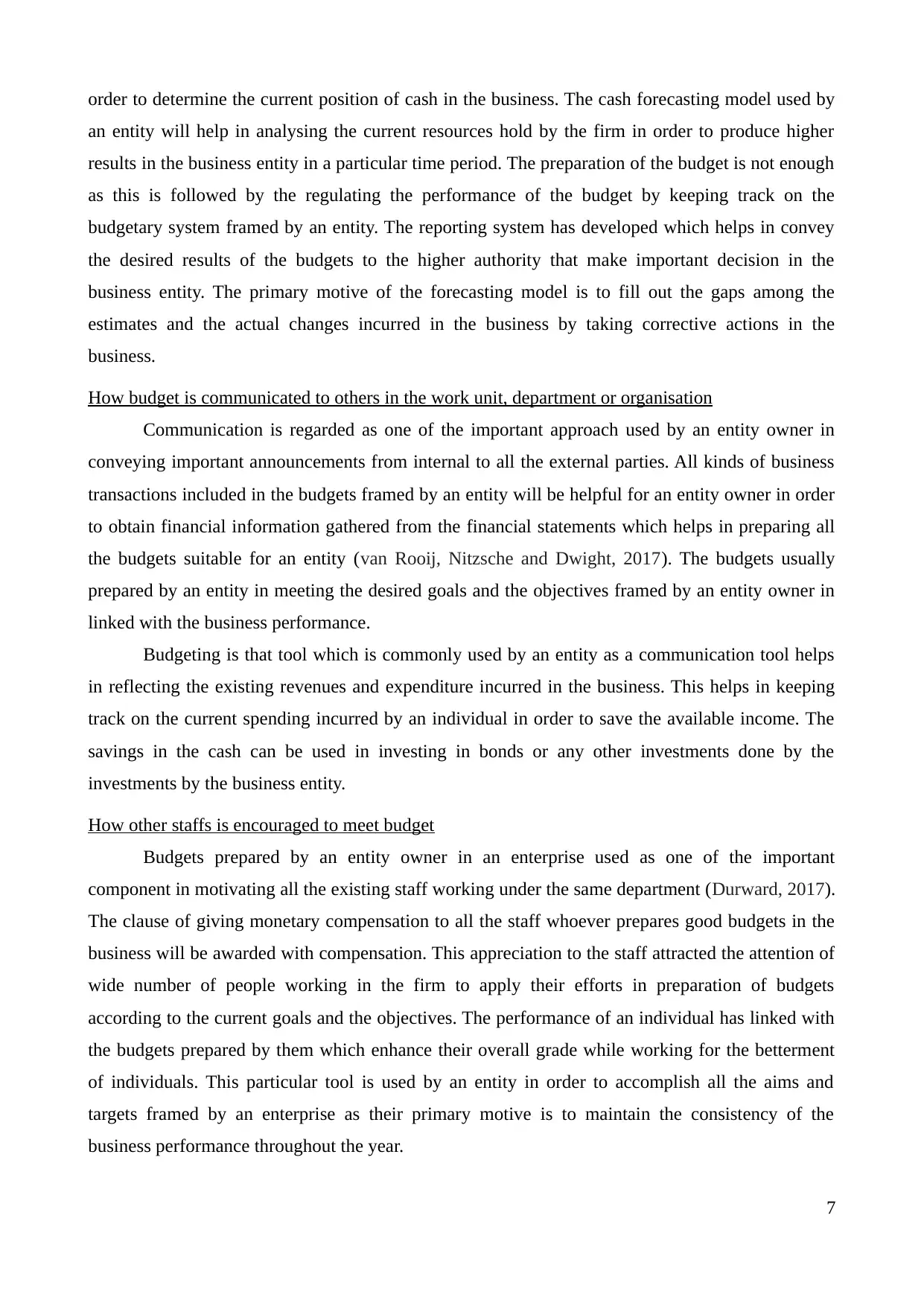
order to determine the current position of cash in the business. The cash forecasting model used by
an entity will help in analysing the current resources hold by the firm in order to produce higher
results in the business entity in a particular time period. The preparation of the budget is not enough
as this is followed by the regulating the performance of the budget by keeping track on the
budgetary system framed by an entity. The reporting system has developed which helps in convey
the desired results of the budgets to the higher authority that make important decision in the
business entity. The primary motive of the forecasting model is to fill out the gaps among the
estimates and the actual changes incurred in the business by taking corrective actions in the
business.
How budget is communicated to others in the work unit, department or organisation
Communication is regarded as one of the important approach used by an entity owner in
conveying important announcements from internal to all the external parties. All kinds of business
transactions included in the budgets framed by an entity will be helpful for an entity owner in order
to obtain financial information gathered from the financial statements which helps in preparing all
the budgets suitable for an entity (van Rooij, Nitzsche and Dwight, 2017). The budgets usually
prepared by an entity in meeting the desired goals and the objectives framed by an entity owner in
linked with the business performance.
Budgeting is that tool which is commonly used by an entity as a communication tool helps
in reflecting the existing revenues and expenditure incurred in the business. This helps in keeping
track on the current spending incurred by an individual in order to save the available income. The
savings in the cash can be used in investing in bonds or any other investments done by the
investments by the business entity.
How other staffs is encouraged to meet budget
Budgets prepared by an entity owner in an enterprise used as one of the important
component in motivating all the existing staff working under the same department (Durward, 2017).
The clause of giving monetary compensation to all the staff whoever prepares good budgets in the
business will be awarded with compensation. This appreciation to the staff attracted the attention of
wide number of people working in the firm to apply their efforts in preparation of budgets
according to the current goals and the objectives. The performance of an individual has linked with
the budgets prepared by them which enhance their overall grade while working for the betterment
of individuals. This particular tool is used by an entity in order to accomplish all the aims and
targets framed by an enterprise as their primary motive is to maintain the consistency of the
business performance throughout the year.
7
an entity will help in analysing the current resources hold by the firm in order to produce higher
results in the business entity in a particular time period. The preparation of the budget is not enough
as this is followed by the regulating the performance of the budget by keeping track on the
budgetary system framed by an entity. The reporting system has developed which helps in convey
the desired results of the budgets to the higher authority that make important decision in the
business entity. The primary motive of the forecasting model is to fill out the gaps among the
estimates and the actual changes incurred in the business by taking corrective actions in the
business.
How budget is communicated to others in the work unit, department or organisation
Communication is regarded as one of the important approach used by an entity owner in
conveying important announcements from internal to all the external parties. All kinds of business
transactions included in the budgets framed by an entity will be helpful for an entity owner in order
to obtain financial information gathered from the financial statements which helps in preparing all
the budgets suitable for an entity (van Rooij, Nitzsche and Dwight, 2017). The budgets usually
prepared by an entity in meeting the desired goals and the objectives framed by an entity owner in
linked with the business performance.
Budgeting is that tool which is commonly used by an entity as a communication tool helps
in reflecting the existing revenues and expenditure incurred in the business. This helps in keeping
track on the current spending incurred by an individual in order to save the available income. The
savings in the cash can be used in investing in bonds or any other investments done by the
investments by the business entity.
How other staffs is encouraged to meet budget
Budgets prepared by an entity owner in an enterprise used as one of the important
component in motivating all the existing staff working under the same department (Durward, 2017).
The clause of giving monetary compensation to all the staff whoever prepares good budgets in the
business will be awarded with compensation. This appreciation to the staff attracted the attention of
wide number of people working in the firm to apply their efforts in preparation of budgets
according to the current goals and the objectives. The performance of an individual has linked with
the budgets prepared by them which enhance their overall grade while working for the betterment
of individuals. This particular tool is used by an entity in order to accomplish all the aims and
targets framed by an enterprise as their primary motive is to maintain the consistency of the
business performance throughout the year.
7
Paraphrase This Document
Need a fresh take? Get an instant paraphrase of this document with our AI Paraphraser
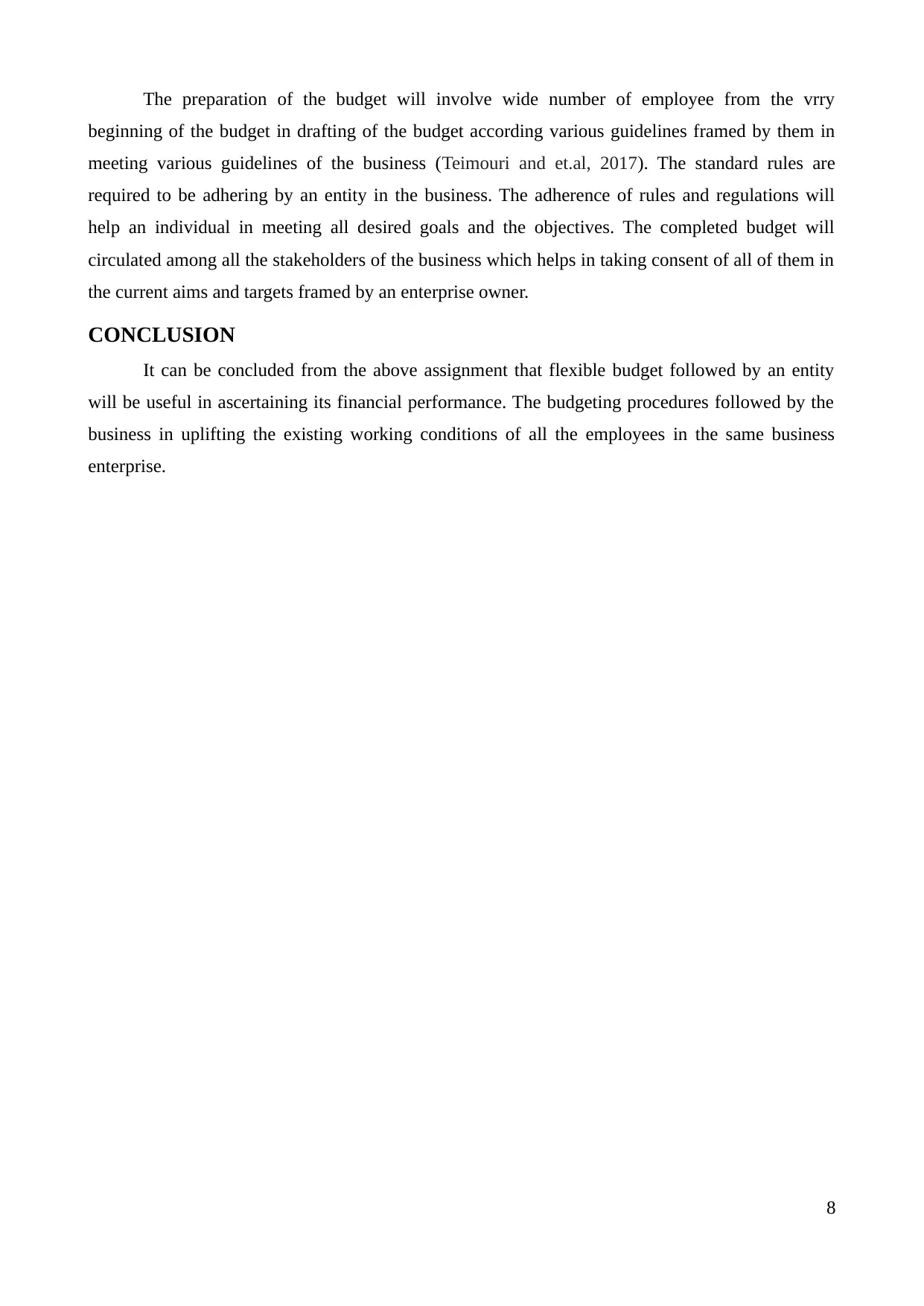
The preparation of the budget will involve wide number of employee from the vrry
beginning of the budget in drafting of the budget according various guidelines framed by them in
meeting various guidelines of the business (Teimouri and et.al, 2017). The standard rules are
required to be adhering by an entity in the business. The adherence of rules and regulations will
help an individual in meeting all desired goals and the objectives. The completed budget will
circulated among all the stakeholders of the business which helps in taking consent of all of them in
the current aims and targets framed by an enterprise owner.
CONCLUSION
It can be concluded from the above assignment that flexible budget followed by an entity
will be useful in ascertaining its financial performance. The budgeting procedures followed by the
business in uplifting the existing working conditions of all the employees in the same business
enterprise.
8
beginning of the budget in drafting of the budget according various guidelines framed by them in
meeting various guidelines of the business (Teimouri and et.al, 2017). The standard rules are
required to be adhering by an entity in the business. The adherence of rules and regulations will
help an individual in meeting all desired goals and the objectives. The completed budget will
circulated among all the stakeholders of the business which helps in taking consent of all of them in
the current aims and targets framed by an enterprise owner.
CONCLUSION
It can be concluded from the above assignment that flexible budget followed by an entity
will be useful in ascertaining its financial performance. The budgeting procedures followed by the
business in uplifting the existing working conditions of all the employees in the same business
enterprise.
8
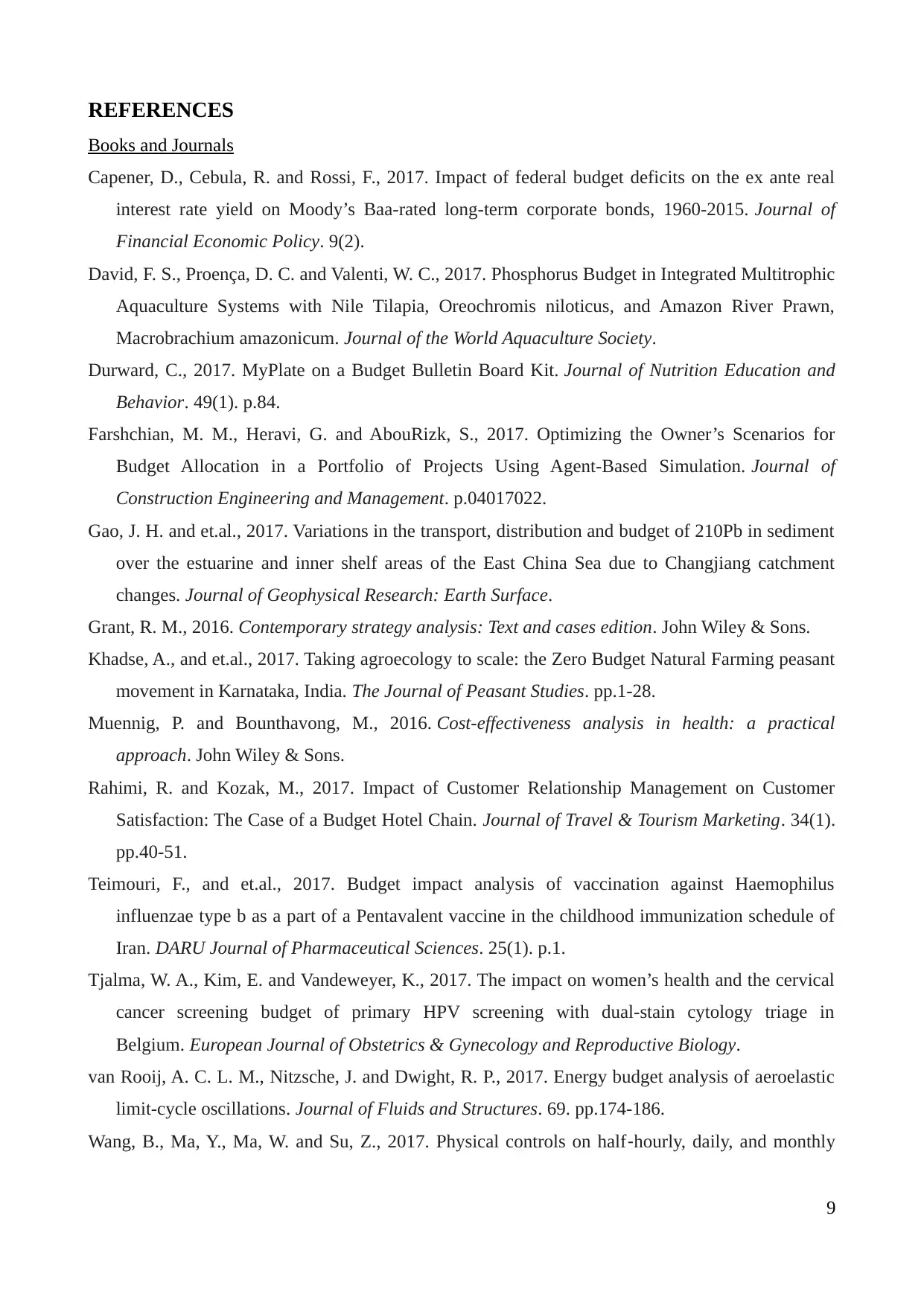
REFERENCES
Books and Journals
Capener, D., Cebula, R. and Rossi, F., 2017. Impact of federal budget deficits on the ex ante real
interest rate yield on Moody’s Baa-rated long-term corporate bonds, 1960-2015. Journal of
Financial Economic Policy. 9(2).
David, F. S., Proença, D. C. and Valenti, W. C., 2017. Phosphorus Budget in Integrated Multitrophic
Aquaculture Systems with Nile Tilapia, Oreochromis niloticus, and Amazon River Prawn,
Macrobrachium amazonicum. Journal of the World Aquaculture Society.
Durward, C., 2017. MyPlate on a Budget Bulletin Board Kit. Journal of Nutrition Education and
Behavior. 49(1). p.84.
Farshchian, M. M., Heravi, G. and AbouRizk, S., 2017. Optimizing the Owner’s Scenarios for
Budget Allocation in a Portfolio of Projects Using Agent-Based Simulation. Journal of
Construction Engineering and Management. p.04017022.
Gao, J. H. and et.al., 2017. Variations in the transport, distribution and budget of 210Pb in sediment
over the estuarine and inner shelf areas of the East China Sea due to Changjiang catchment
changes. Journal of Geophysical Research: Earth Surface.
Grant, R. M., 2016. Contemporary strategy analysis: Text and cases edition. John Wiley & Sons.
Khadse, A., and et.al., 2017. Taking agroecology to scale: the Zero Budget Natural Farming peasant
movement in Karnataka, India. The Journal of Peasant Studies. pp.1-28.
Muennig, P. and Bounthavong, M., 2016. Cost-effectiveness analysis in health: a practical
approach. John Wiley & Sons.
Rahimi, R. and Kozak, M., 2017. Impact of Customer Relationship Management on Customer
Satisfaction: The Case of a Budget Hotel Chain. Journal of Travel & Tourism Marketing. 34(1).
pp.40-51.
Teimouri, F., and et.al., 2017. Budget impact analysis of vaccination against Haemophilus
influenzae type b as a part of a Pentavalent vaccine in the childhood immunization schedule of
Iran. DARU Journal of Pharmaceutical Sciences. 25(1). p.1.
Tjalma, W. A., Kim, E. and Vandeweyer, K., 2017. The impact on women’s health and the cervical
cancer screening budget of primary HPV screening with dual-stain cytology triage in
Belgium. European Journal of Obstetrics & Gynecology and Reproductive Biology.
van Rooij, A. C. L. M., Nitzsche, J. and Dwight, R. P., 2017. Energy budget analysis of aeroelastic
limit-cycle oscillations. Journal of Fluids and Structures. 69. pp.174-186.
Wang, B., Ma, Y., Ma, W. and Su, Z., 2017. Physical controls on half‐hourly, daily, and monthly
9
Books and Journals
Capener, D., Cebula, R. and Rossi, F., 2017. Impact of federal budget deficits on the ex ante real
interest rate yield on Moody’s Baa-rated long-term corporate bonds, 1960-2015. Journal of
Financial Economic Policy. 9(2).
David, F. S., Proença, D. C. and Valenti, W. C., 2017. Phosphorus Budget in Integrated Multitrophic
Aquaculture Systems with Nile Tilapia, Oreochromis niloticus, and Amazon River Prawn,
Macrobrachium amazonicum. Journal of the World Aquaculture Society.
Durward, C., 2017. MyPlate on a Budget Bulletin Board Kit. Journal of Nutrition Education and
Behavior. 49(1). p.84.
Farshchian, M. M., Heravi, G. and AbouRizk, S., 2017. Optimizing the Owner’s Scenarios for
Budget Allocation in a Portfolio of Projects Using Agent-Based Simulation. Journal of
Construction Engineering and Management. p.04017022.
Gao, J. H. and et.al., 2017. Variations in the transport, distribution and budget of 210Pb in sediment
over the estuarine and inner shelf areas of the East China Sea due to Changjiang catchment
changes. Journal of Geophysical Research: Earth Surface.
Grant, R. M., 2016. Contemporary strategy analysis: Text and cases edition. John Wiley & Sons.
Khadse, A., and et.al., 2017. Taking agroecology to scale: the Zero Budget Natural Farming peasant
movement in Karnataka, India. The Journal of Peasant Studies. pp.1-28.
Muennig, P. and Bounthavong, M., 2016. Cost-effectiveness analysis in health: a practical
approach. John Wiley & Sons.
Rahimi, R. and Kozak, M., 2017. Impact of Customer Relationship Management on Customer
Satisfaction: The Case of a Budget Hotel Chain. Journal of Travel & Tourism Marketing. 34(1).
pp.40-51.
Teimouri, F., and et.al., 2017. Budget impact analysis of vaccination against Haemophilus
influenzae type b as a part of a Pentavalent vaccine in the childhood immunization schedule of
Iran. DARU Journal of Pharmaceutical Sciences. 25(1). p.1.
Tjalma, W. A., Kim, E. and Vandeweyer, K., 2017. The impact on women’s health and the cervical
cancer screening budget of primary HPV screening with dual-stain cytology triage in
Belgium. European Journal of Obstetrics & Gynecology and Reproductive Biology.
van Rooij, A. C. L. M., Nitzsche, J. and Dwight, R. P., 2017. Energy budget analysis of aeroelastic
limit-cycle oscillations. Journal of Fluids and Structures. 69. pp.174-186.
Wang, B., Ma, Y., Ma, W. and Su, Z., 2017. Physical controls on half‐hourly, daily, and monthly
9
⊘ This is a preview!⊘
Do you want full access?
Subscribe today to unlock all pages.

Trusted by 1+ million students worldwide
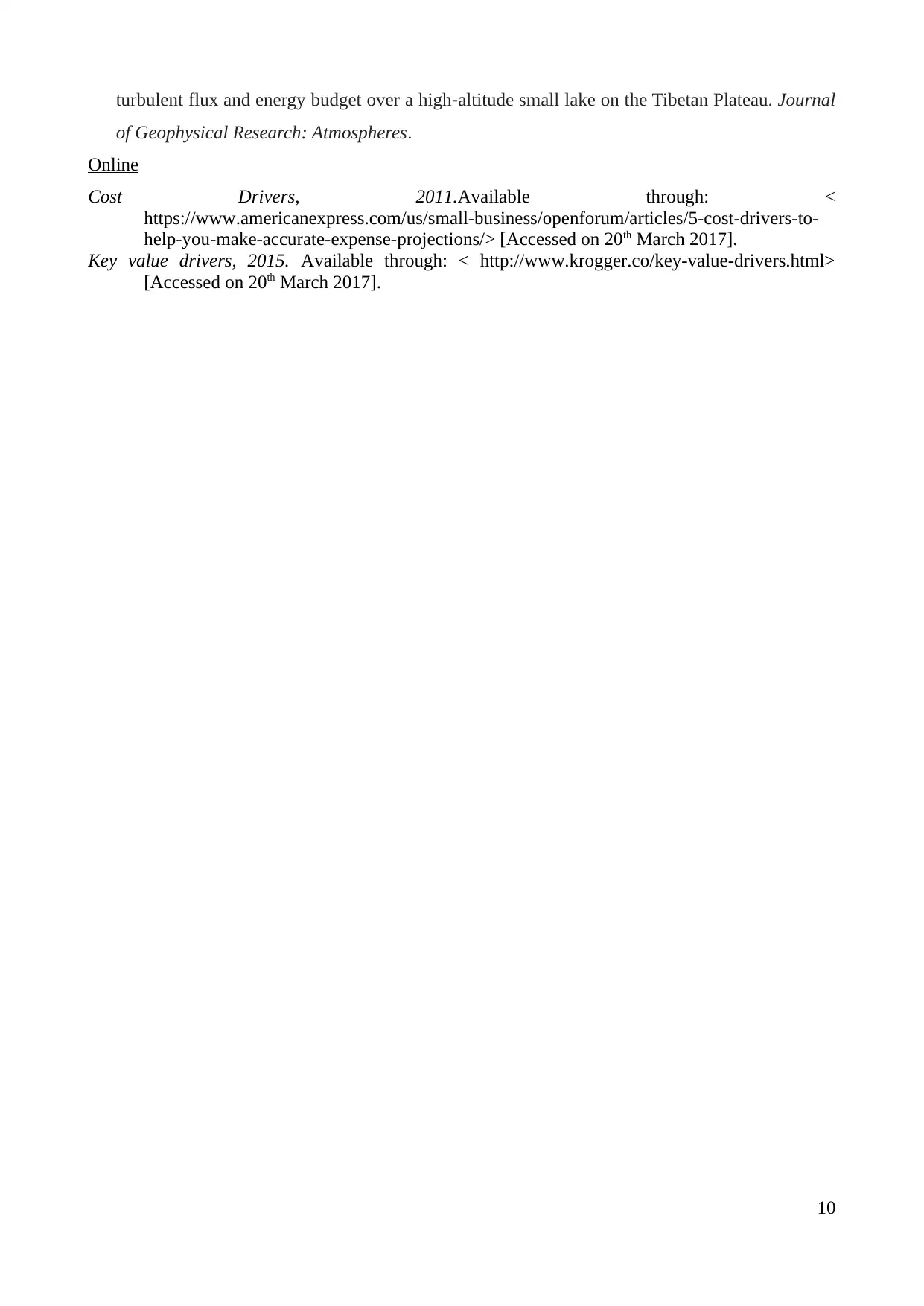
turbulent flux and energy budget over a high‐altitude small lake on the Tibetan Plateau. Journal
of Geophysical Research: Atmospheres.
Online
Cost Drivers, 2011.Available through: <
https://www.americanexpress.com/us/small-business/openforum/articles/5-cost-drivers-to-
help-you-make-accurate-expense-projections/> [Accessed on 20th March 2017].
Key value drivers, 2015. Available through: < http://www.krogger.co/key-value-drivers.html>
[Accessed on 20th March 2017].
10
of Geophysical Research: Atmospheres.
Online
Cost Drivers, 2011.Available through: <
https://www.americanexpress.com/us/small-business/openforum/articles/5-cost-drivers-to-
help-you-make-accurate-expense-projections/> [Accessed on 20th March 2017].
Key value drivers, 2015. Available through: < http://www.krogger.co/key-value-drivers.html>
[Accessed on 20th March 2017].
10
1 out of 10
Related Documents
Your All-in-One AI-Powered Toolkit for Academic Success.
+13062052269
info@desklib.com
Available 24*7 on WhatsApp / Email
![[object Object]](/_next/static/media/star-bottom.7253800d.svg)
Unlock your academic potential
Copyright © 2020–2025 A2Z Services. All Rights Reserved. Developed and managed by ZUCOL.




